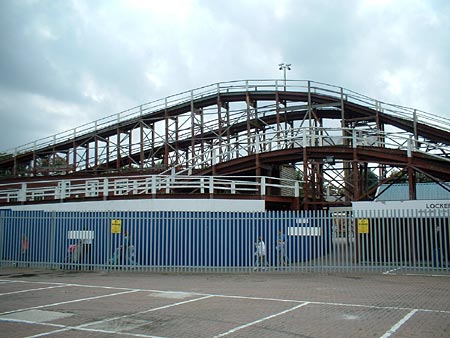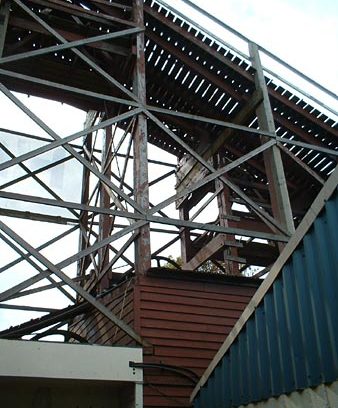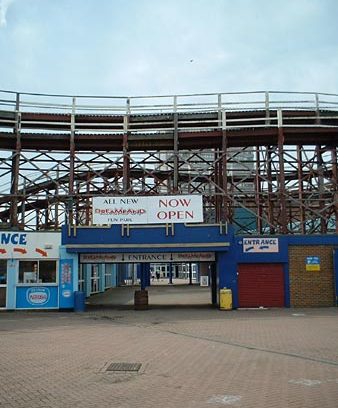This website uses cookies
This website uses cookies to enable it to function properly and to analyse how the website is used. Please click 'Close' to accept and continue using the website.






October 2006 - Scenic railway at Dreamland
Text and photographs by Nick Dermott RIBA
Margate has re-invented itself several times. In five hundred years it has changed from a monastic farmstead to an aristocratic watering hole to a place of entertainment for the masses and it is at present, some times painfully, attempting to transform itself into a centre for the arts. But for many, Margate is still two things: a broad sandy beach and Dreamland.
The backdrop for Margate Sands is a much compromised terrace of 1820s houses – with amusement arcades on the ground floor – built on a man-made causeway across the mouth of the River Mere. The 6.5-hectare area of land bounded by this causeway, and a railway embankment constructed in 1864, is low-lying, damp and hidden from view. In the 1880s the idiosyncratic circus promoter, ‘Lord’ George Sanger, acquired the land for use as pleasure gardens, drained it and planted groves of trees. He also added a mock ruined abbey, a lake, a ‘Romanesque’ garden with terraces, statuary and, at night, flaming torches and a zoo. The only sea frontage that the enterprise had was the end of a never-used railway terminus, which Sanger converted in to a dance hall and named the ‘Hall by the Sea’.
In 1919 John Henry Iles, the owner of an advertising agency, bought the park, renamed it Dreamland and modernised it, having been much impressed by the inventiveness, and profitability, of American amusement parks – especially the ‘Luna’ and ‘Dreamland’ sites at New York’s Coney Island. Over the next 15 years, Iles invested heavily in the site, culminating in 1933 in the building of the Dreamland leisure complex. This structure, by the architects Leathart and Grainger, combined a 2000-seat cinema, bars, restaurants and an amusement arcade-lined tunnel into the park. A truly striking and original building, it came to be the prototype for the Odeon house style of 1935 onwards and was listed in 1992.
Iles’ first investment at Dreamland was the Scenic Railway, opened in 1920. The scenic railway ride, originating in America, is the precursor of the modern roller coaster but with some important differences. Whereas a rollercoaster has under wheels to resist its propensity to leave the track on sharp bends, a scenic railway works in the same way as a conventional railway. To control it a brakeman, who in the Margate example sits at the front of the second of three carriages, has to judge the speed and momentum of the ride and pull a brake lever accordingly. The carriages are pulled up the major inclines by a grab cable after which they run under gravity. Spectacularly different effects can result, depending on the number of passengers, the weather conditions and, most importantly, the different styles of individual brakemen. The ride is large, 180m by 30m and the superstructure is entirely constructed of timber. The looping track is ¾ mile long, with the average ride, carrying up to 28 people, taking four minutes; although it has, at times, seemed much longer to me. Occasionally, two trains are run on the track simultaneously, although, historically, up to five trains were run at the same time, this being when the cars had no seat belts and passengers boarded and left the train while it was still moving through the ‘station’.
The Scenic Railway at Margate is one of the only two surviving examples of this, once common, type of roller coaster left in the United Kingdom. The other example, from 1932, although much altered, being at Great Yarmouth. The Margate scenic railway is also the third oldest example left in the world after Melbourne, Australia (1912) and Copenhagen, Denmark (1914). There are no examples, of any period, surviving in the United States. It was a bold and forward-looking decision by the Department for Culture, Media and Sport to list the Margate railway (grade II) on 1st March 2002.
Dreamland acquired new owners in 1995. At this time there were still considerable survivals on the site from the pre Iles’ period: trees, terraces and zoo buildings. These were all swept away – the site lying outside the Margate conservation area – as were all the fixed rides, some of considerable antiquity, with the exception of the Scenic Railway. In January 2003 the owners announced that the park was to close since it was no longer profitable. Since then the railway has still operated every summer, although it now looms over a small collection of travelling rides.
The town of Margate contains many fine things but the Scenic Railway is ‘close to being unique’. With the exception of the 1939-45 period it has been operated every summer since 1920 and has always proved popular. During 2003, the most recent year for which figures are available, it carried 30,000 passengers and made a healthy profit. It is so large that it does not seem unreasonable to argue that the entire park is its setting. Margate does not need new houses or a shopping centre here.
Today the future for this structure looks no better than when it was listed: it was already considered to be under threat then. A campaign has been set up to promote the preservation of Dreamland. Further information can be gained from the campaign’s website at www.savedreamland.co.uk.
Nick Dermott is an architect.
Look for past Buildings of the Month by entering the name of an individual building or architect or browsing the drop down list.

Become a C20 member today and help save our modern design heritage.